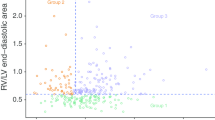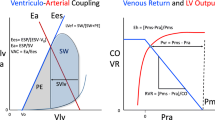Abstract
Objectives
To define a variable which could reliability predict when fluid resuscitation as monotherapy is not expected to improve organ perfusion pressure, owing to limitations in cardiac output responsiveness in patients with severe sepsis.
Design
Prospective controlled trial.
Setting
Anesthesiological ICU in a university hospital.
Patients
Twenty seven patients in early septic shock states (MAP<60 mmHg).
Interventions
Infusion therapy was titrated until no further increase in cardiac index and mean arterial pressure could be achieved. Fluid resuscitation as monotherapy was deemed unsuccessful at the end of 2 h if inotropic or vasoactive pharmacologic support was required to maintain a mean arterial pressure > 60 mmHg.
Measurements and results
We investigated the hemodynamic course during fluid resuscitation (2850±210 ml crystalloids) with special emphasis on right heart function using the thermodilution technique. Eleven patients (group A) had a right ventricular (RV) ejection fraction below 45%. In this group positive inotropic and/or vasoactive drugs were obligatory to achieve and maintain a sufficient perfusion pressure (MAP>60 mmHg) after fluid challenge.
Conclusions
In 27 septic shock patients investigated, we diagnosed right ventricular dysfunction in 41%. In this specific patient population fluid replacement alone did not succeed in stabilizing hemodynamic variables, therefore necessitating catecholamine therapy.
Similar content being viewed by others
References
Ognibene FP, Parker MM, Natanson C, Shelhamer JH, Parrillo JE (1988) Depressed left ventricular performance. Response to volume infusion in patients with sepsis and septic shock. Chest 93:903–910
Meadows D, Edwards JD, Wilkins RG, Nightingale P (1988) Reversal of intractable septic shock with norepinephrine therapy. Crit Care Med 16:663–669
Thijs LG, Groeneveld ABJ (1988) Peripheral circulation in septic shock. Appl Cardiopulmonol Pathophysiol 2:203–209
Sibbald WJ, Driedger AA (1983) Right ventricular function in acute disease states: Pathophysiologic considerations. Crit Care Med 11:339
Vlahakes GJ, Turley K, Hoffmann JI (1981) The pathophysiology of failure in acute right ventricular hypertension: hemodynamic and biochemical correlations. Circulation 63:87–95
Fixler DE, Archie JP, Ullyot DJ (1973) Effects of acute right ventricular systolic hypertension of regional myocardial blood flow in anesthetized dogs. Am Heart J 85:491–499
Hesw DS, Bachew RJ (1979) Transmural right ventricular myocardial blood flow during systole in the awake dog. Circ Res 44:88–94
Lefer AM (1970) Role of a myocardial depressant factor in the pathogenesis of circulatory shock. Fed Proc 29:1836–1845
Cunnion RE, Parrillo JE (1989) Myocardial dysfunction in sepsis. Crit Care Clin 5:99–118
Chernow B, Roth BL (1986) Pharmacologic manipulation of the peripheral vasculature in shock: clinical and experimental approaches. Circ Shock 18:141–155
Wiedemann HP, Matthay A (1985) Acute right heart failure. Crit Care Clin 1:631–661
Dhainaut JF, Brunet F, Monsallier JF, Villemant D, Devaux JY, Konno M, Gournay JM, Armaganidis A, Iotti G, Huyghebaert MF, Lanore JJ (1987) Bedside evaluation of right ventricular performance using a rapid computerized thermodilution method. Crit Care Med 15:148–152
Bone RC, Fisher CJ, Clemmer TP, Slotman GJ, Metz CA, Balk RA (1989) Sepsis syndrome: a valid clinical entity. Crit Care Med 17:389–393
Martyn J, Wilson RS, Burke JF (1986) Right ventricular function and pulmonary hemodynamics during dopamine infusion in burned patients. Chest 89:357–360
Hodgin JE, Cress DB, Wertz RA (1984) Equations and “rules of thumb” for management of patients. In: Burton GG, Hodgin JE (eds) Respiratory care. Lippincott, Philadelphia
Dhainaut JF, Brunet F, Lanore JJ (1991) Validity and clinical applications of fast response thermistor for right ventricular ejection fraction monitoring. In: Dhainaut JF, Payen D (eds) Strategy in bedside hemodynamic monitoring. Springer, Berlin Heidelberg New York
Reinhart K, Hannemann L, Kuss B (1990) Optimal oxygen delivery in critically ill patients. Intensive Care Med 16:149–155
Chang N, Goodson WH, Gottrup F, Hunt TK (1983) Direct measurement of wound and tissue oxygen tension in postoperative patients. Ann Surg 197:470–478
Babior BM (1987) Oxygen-dependent microbial killing by phagocytes. N Engl J Med 298:659–668
Groeneveld ABJ, Nauta JJP, Thijs LG (1988) Peripheral vascular resistance in septic shock: its relation to outcome. Intensive Care Med 14:141–147
Martyn JAJ, Snider MT, Farago LF, Burke J (1981) Thermodilution right ventricular volume; a novel and better predictor of volume replacement in acute thermal injury. J Trauma 21:619–626
Kay HR, Afshari M, Barash P, Webler W, Iskandrian A, Bemis C, Hakki AH, Mundt ED (1983) Measurement of ejection fraction by thermal dilution technique. J Surg Res 34:337–346
Urban P, Scheidegger D, Gabathuler J, Rutishauser W (1987) Thermodilution determination of right ventricular volume and ejection fraction: a comparison with biplane angiography. Crit Care Med 15:652–655
Jardin F, Gueret P, Dubourg O, Farcot JC, Margairaz A, Bourdarias JP (1985) Right ventricular volumes by thermodilution in the adult respiratory distress syndrome. A comparative study using two dimensional echocardiography as reference method. Chest 88:34–39
Schneider AJ, Teule GJJ, Groeneveld ABJ (1988) Biventricular performance during volume loading in patients with early septic shock, with emphasis on the right ventricle: a combined hemodynamic and radionuclide study. Am Heart J 116:103–110
Kimchi A, Ellrodt AG, Berman DS, Riedinger MS, Swan HJC (1984) Right ventricular performance in septic shock: a combined radionuclide and hemodynamic study. J Am Coll Cardiol 4:945–951
Jardin F, Brunney D, Auvert B (1990) Sepsis-related cardiogenic shock. Crit Care Med 18:1055–1062
Parker MM, McCarthy KE, Ognibene FP, Parrillo JE (1990) Right ventricular dysfunction and dilatation, similar to left ventricular changes, characterize the cardiac depression of septic shock in humans. Chest 97:126–131
Redl G, Newald J, Schlag G, Traber LD, Traber LD, Traber DL (1991) Cardiac function in an ovine model of endotoxemia. Circ Shock 35:31–36
Robin ED (1987) Death by pulmonary artery flow-directed catheter: time for a moratorium? Chest 92:727–731
Redl-Wenzl EM, Armbruster C, Edelmann G, Fischl E, Kolacny M, Wechsler-Fördös A, Sporn P (1990) Noradrenalin im “High Output-Low Resistance State” beim septischen Abdominalpatienten. Anaesthesist 39:525–529
Author information
Authors and Affiliations
Rights and permissions
About this article
Cite this article
Redl, G., Germann, P., Plattner, H. et al. Right ventricular function in early septic shock states. Intensive Care Med 19, 3–7 (1993). https://doi.org/10.1007/BF01709270
Received:
Accepted:
Issue Date:
DOI: https://doi.org/10.1007/BF01709270




